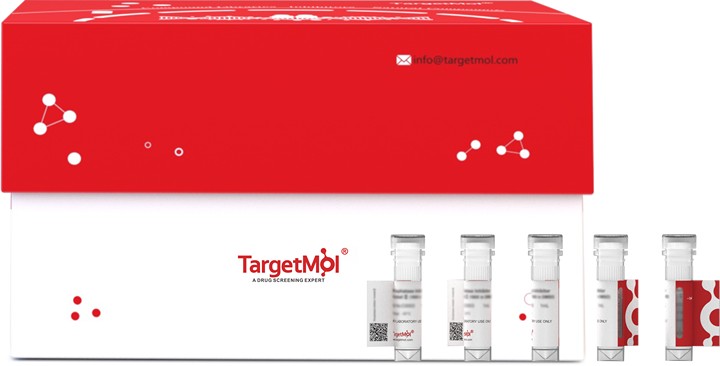 Your shopping cart is currently empty
Your shopping cart is currently empty
CR1L Protein, Mouse, Recombinant (His)
Catalog No. TMPH-02606
Acts as a cofactor for complement factor I, a serine protease which protects autologous cells against complement-mediated injury by cleaving C3b and C4b deposited on host tissue. Also acts as a decay-accelerating factor, preventing the formation of C4b2a and C3bBb, the amplification convertases of the complement cascade. Plays a crucial role in early embryonic development by maintaining fetomaternal tolerance. Also acts as a costimulatory factor for T-cells which favors IL-4 secretion. CR1L Protein, Mouse, Recombinant (His) is expressed in E. coli expression system with N-6xHis tag. The predicted molecular weight is 44.5 kDa and the accession number is Q64735.

CR1L Protein, Mouse, Recombinant (His)
Catalog No. TMPH-02606
Acts as a cofactor for complement factor I, a serine protease which protects autologous cells against complement-mediated injury by cleaving C3b and C4b deposited on host tissue. Also acts as a decay-accelerating factor, preventing the formation of C4b2a and C3bBb, the amplification convertases of the complement cascade. Plays a crucial role in early embryonic development by maintaining fetomaternal tolerance. Also acts as a costimulatory factor for T-cells which favors IL-4 secretion. CR1L Protein, Mouse, Recombinant (His) is expressed in E. coli expression system with N-6xHis tag. The predicted molecular weight is 44.5 kDa and the accession number is Q64735.
| Pack Size | Price | USA Warehouse | Global Warehouse | Quantity |
|---|---|---|---|---|
| 5 μg | $105 | 20 days | 20 days | |
| 10 μg | $169 | 20 days | 20 days | |
| 20 μg | $283 | 20 days | 20 days | |
| 50 μg | $428 | 20 days | 20 days | |
| 100 μg | $590 | 20 days | 20 days | |
| 200 μg | $913 | 20 days | 20 days | |
| 500 μg | $1,620 | 20 days | 20 days | |
| 1 mg | $2,530 | 20 days | 20 days |
Add to Cart
Add to Quotation
In Stock Estimated shipping dateUSA Warehouse [1-2 days] Global Warehouse [5-7 days]
All TargetMol products are for research purposes only and cannot be used for human consumption. We do not provide products or services to individuals. Please comply with the intended use and do not use TargetMol products for any other purpose.
Resource Download
Product Information
| Biological Activity | Activity has not been tested. It is theoretically active, but we cannot guarantee it. If you require protein activity, we recommend choosing the eukaryotic expression version first. |
| Description | Acts as a cofactor for complement factor I, a serine protease which protects autologous cells against complement-mediated injury by cleaving C3b and C4b deposited on host tissue. Also acts as a decay-accelerating factor, preventing the formation of C4b2a and C3bBb, the amplification convertases of the complement cascade. Plays a crucial role in early embryonic development by maintaining fetomaternal tolerance. Also acts as a costimulatory factor for T-cells which favors IL-4 secretion. CR1L Protein, Mouse, Recombinant (His) is expressed in E. coli expression system with N-6xHis tag. The predicted molecular weight is 44.5 kDa and the accession number is Q64735. |
| Species | Mouse |
| Expression System | E. coli |
| Tag | N-6xHis |
| Accession Number | Q64735 |
| Synonyms | Protein p65,Cry,Crry,Cr1l,Complement regulatory protein Crry,Complement component receptor 1-like protein |
| Amino Acid | ELRGGLGKHGHTVHREPAVNRLCADSKRWSGLPVSAQRPFPMGHCPAPSQLPSAKPINLTDESMFPIGTYLLYECLPGYIKRQFSITCKQDSTWTSAEDKCIRKQCKTPSDPENGLVHVHTGIQFGSRINYTCNQGYRLIGSSSAVCVITDQSVDWDTEAPICEWIPCEIPPGIPNGDFFSSTREDFHYGMVVTYRCNTDARGKALFNLVGEPSLYCTSNDGEIGVWSGPPPQCIELNKCTPPPYVENAVMLSENRSLFSLRDIVEFRCHPGFIMKGASSVHCQSLNKWEPELPSCFKGVICRLPQEMSGFQKGLGMKKEYYYGENVTLECEDGYTLEGSSQSQCQSDGSWNPLLAKCVSRSISG |
| Construction | 41-405 aa |
| Protein Purity | > 85% as determined by SDS-PAGE. |
| Molecular Weight | 44.5 kDa (predicted) |
| Endotoxin | < 1.0 EU/μg of the protein as determined by the LAL method. |
| Formulation | Tris-based buffer, 50% glycerol |
| Reconstitution | A Certificate of Analysis (CoA) containing reconstitution instructions is included with the products. Please refer to the CoA for detailed information. |
| Stability & Storage | Lyophilized powders can be stably stored for over 12 months, while liquid products can be stored for 6-12 months at -80°C. For reconstituted protein solutions, the solution can be stored at -20°C to -80°C for at least 3 months. Please avoid multiple freeze-thaw cycles and store products in aliquots. |
| Shipping | In general, Lyophilized powders are shipping with blue ice. Solutions are shipping with dry ice. |
| Research Background | Acts as a cofactor for complement factor I, a serine protease which protects autologous cells against complement-mediated injury by cleaving C3b and C4b deposited on host tissue. Also acts as a decay-accelerating factor, preventing the formation of C4b2a and C3bBb, the amplification convertases of the complement cascade. Plays a crucial role in early embryonic development by maintaining fetomaternal tolerance. Also acts as a costimulatory factor for T-cells which favors IL-4 secretion. |
Dose Conversion
You can also refer to dose conversion for different animals. More
Calculator
Tech Support
Please read the User Guide of Recombinant Proteins for more specific information.
Generate Quote
Catalog No.: Cas No.:
Add
| Size | Quantity | Unit Price | Amount | Operation |
|---|
Generate Quote

Copyright © 2015-2025 TargetMol Chemicals Inc. All Rights Reserved.



